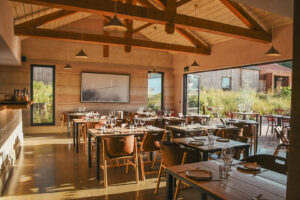
Restaurant Supervisor
Knepp Wilding Kitchen- Restaurant Supervisor Job Description We are looking for a dynamic, enthusiastic and experienced front-of-house professional looking for a new challenge and to
Last guaranteed pre-Christmas order date for Butchery and Gift items: 16th Dec. Dismiss
Skip to contentHome / January: Seeds, surveys and sand

Moy Fierheller | Deputy Head Gardener
The year in the garden begins in Narnia; hoar frosts create spiky ice haloes on every seedhead, grass blade, tiny wall-clinging moss mound and naked branch. A magical realm that seems to be holding its breath until the low amber sun lights up orange stands of purple moor grass (Molinia ‘Heidebraut’) and white, exploding-firework snapshots of golden oat grass (Stipa gigantea) among shades of silvers, oyster-greys and fox-browns in an exhalation of colour. The ephemeral pond is a frozen sheet of swirling mosaic patterns, the occasional wild carrot seedhead and defiant sedge fronds stand upright, stubbornly disregarding the harsh growing conditions. Creeping buttercup peeks out here and there from beneath the carapace, unperturbed.
We are constantly challenged in our expectations of the outcomes of allowing natural processes. As horticulturalists, asked to provide a plant list for a bed that is baked hard in the summer and sits wet or frozen all winter, our response would no doubt involve some furrowed brows and sparse suggestions. But relinquishing control over those pioneer native species like ribwort plantain, creeping buttercup, wild carrot, dock and soft rush grass means there are roots in the soil, nectar for native insects, cover for amphibians and seedheads for songbirds with our only input an occasional edit. They also act as a foil amongst the tougher planted plants that give the area structure and colour through the season – the Siberian irises (Iris sibirica ‘Shirley Pope’ and ‘Silver Edge’), purple loosestrife (Lythrum salicaria), Chinese silver grass (Miscanthus sinensis ‘Ferner Osten’ and ‘Flamingo’) and asters (Symphyotrichum ‘Pink Star’).
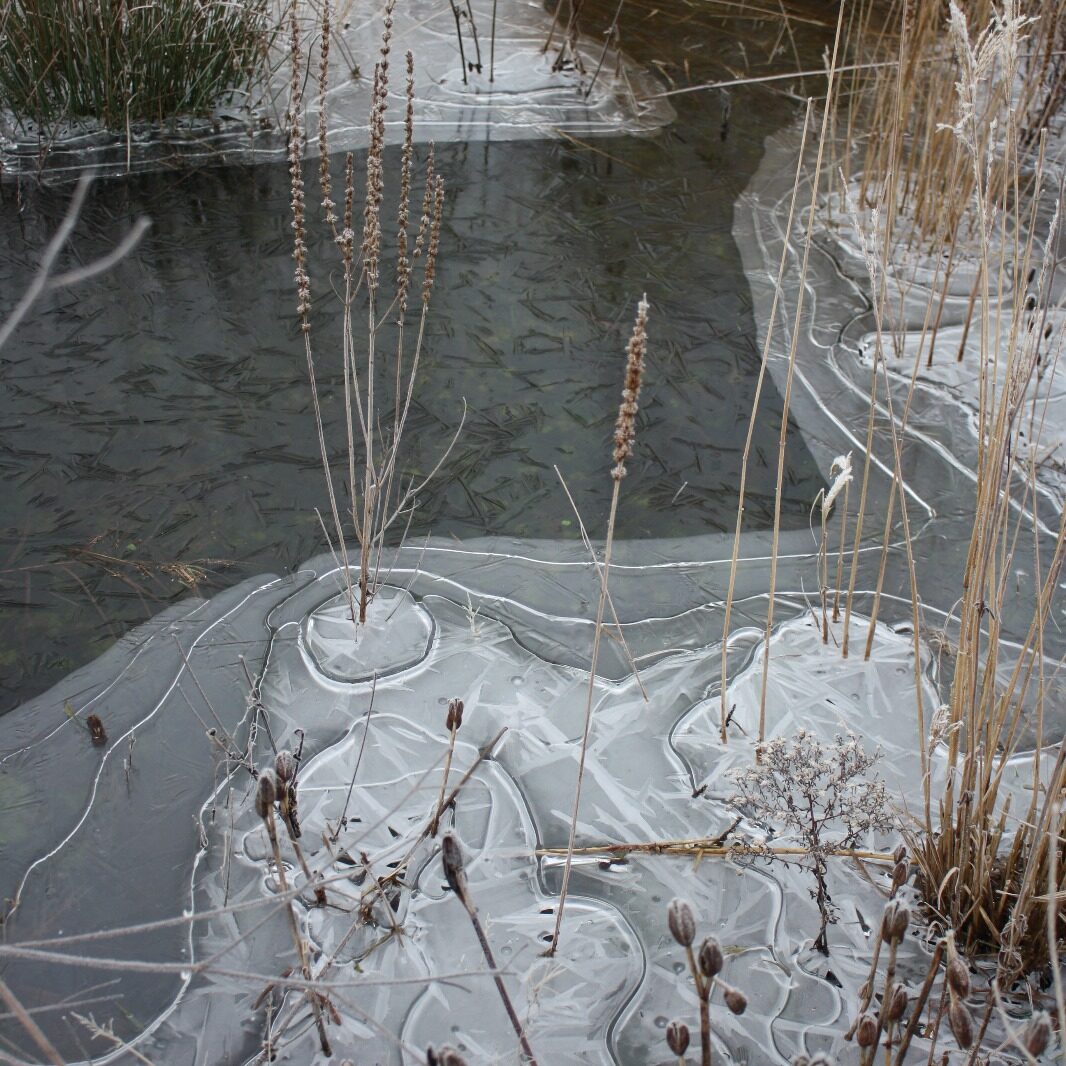
While the ground is hard we retreat to the office to catch up on seed ordering. There is a natural rise and fall in species numbers in the garden, dictated by annual and biennial plantings, self-seeding, responses to weather extremes or ground compaction. Just as the ground is cleared and colonised with broad leaf species by the action of the free-roaming herbivores and Tamworth pigs in the rewilding project, we will act as animal proxies in the Walled Garden and make space for new species. A large proportion of the ordering falls to Suzi who manages the annual and perennial vegetables grown in the Kitchen Garden. We try to support small-scale suppliers such as Tamar organics that produce open-pollinated seed and heritage varieties that might take just that little bit of extra care and perseverance to grow but help keep plant diversity alive.
Some of the ornamental seed additions are to provide adult or larval stage food for more specialist bees, particularly those that inhabit chalk downlands – the undulating mix of crushed concrete and sand in the Rewilded Garden mimics some aspects of this landscape. The bellflower blunthorn bee and the clover blunthorn bee that favour these habitats rely on the Campanula genus as a major food source, and the large and small scabious mining bees are exclusive pollen feeders of scabious flowers. We’ve ordered seeds of the three native common, clustered and nettle-leaf bellflowers (Campanula rotundifolia, C. glomerata, C. trachelium) to augment our existing non-natives, the peach–leaf and milky bellflower (C. persicifolia and C. lactiflora ‘Pritchards Variety’). We have a thriving community of small scabious and Cretian pincushion (Scabiosa columbaria and S. cretica) already established. We’ll start growing a good number of devil’s-bit scabious (Succisa pratensis) this spring and monitor all these new plants throughout the season to see if our efforts pay off in increasing biodiversity.
We’re wonderfully lucky at Knepp to have some incredible ecologists on site, and Fleur Dobner, the Assistant Ecologist has used the winter hiatus to pull together some figures from the ecology department’s monthly garden surveys over the last four years. A baseline survey was conducted in 2020, before the project to rewild the Walled Garden began, and subsequent surveys were undertaken through the season at regular intervals. These are broader based than our more in-depth, three-yearly pan-species invertebrate surveys, covering Odonata (predatory flying insects that include dragon and damsel flies), butterflies and moths, birds, mammals and invertebrates. Although some counts are incomplete as yet, there are some encouraging headlines. Five UK species of bat have been recorded (common pipistrelle and noctule, serotine, Brandt’s and soprano pipistrelle), suggesting we therefore have a greater number of moths in the garden than recorded (63 species in 2022-23) due to their predator-prey relationship. Thirty-five bird species, including a BoCC (Birds of Conservation Concern) Red-List species, the spotted flycatcher, found refuge here. Silver-washed fritillary and painted lady butterflies were amongst the fifteen species recorded, and four species of dragonfly – the fabulously named common darter, emperor dragonfly, migrant hawker and willow emerald – were all spotted in the garden. A total of 908 individual species were documented over the four years, but there is room for improvement. Surveying not only helps us communicate verified results and information to visitors but also enables us to understand what habitats are missing and where we might focus our attention.
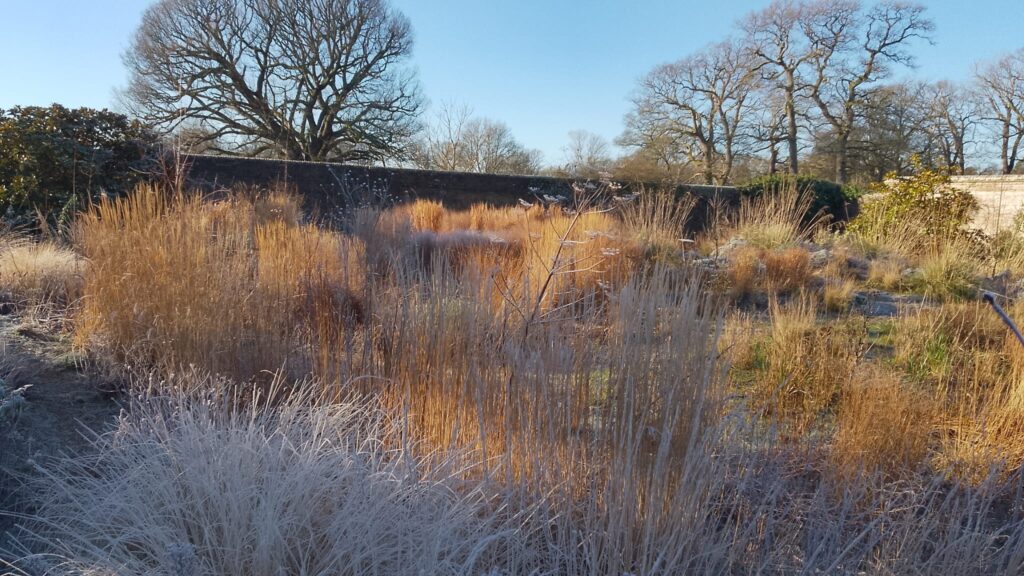
Last month, we spent some time investigating sustainable sources of sand and aggregates to expand habitat for insects. With the delivery of a generous mound of recycled washed sharp sand, we could address two areas of the Rewilded Garden that showed signs of compaction issues during the wet summer in 2024. Where heavy machinery used by the landscaping contractors in the garden redesign used repeated pathways, the heavy Wealden clay beneath the aggregate mulch has become completely devoid of oxygen, causing some plants to have trouble taking up nutrients and trace elements. Particularly affected were three beautiful Persian silk trees (Albizia julibrisson) whose growth has been slow and punctuated by yellowing leaves showing iron and magnesium deficiencies. With delicate mimosa-like leaves that demurely close up at night, and candy-pink, feathered flowers like extravagant false eyelashes, its natural range is from the Middle East to Ethiopia, although it is a common sight in France, liking free-draining, sunny and sheltered spots. We set about lifting the small trees and in one area, agitated the solid pan 80cm beneath the sand and crushed concrete layer with a mini digger. The solid lumps of blue and yellow clay confirmed our suspicions of anaerobic conditions. After breaking up the clay, we mounded up above ground level with the recycled sand to a depth of 30cm, replanted the tree and surrounding perennials, having washed the roots free of remaining compost to encourage strong growth. We created a small mound with some of the clods of excavated clay to record over time what species of plant might colonise it, how quickly and whether any invertebrates might find it useful. Many visitors share this toughest of growing mediums in their own gardens and hopefully we might usefully share our findings with them.
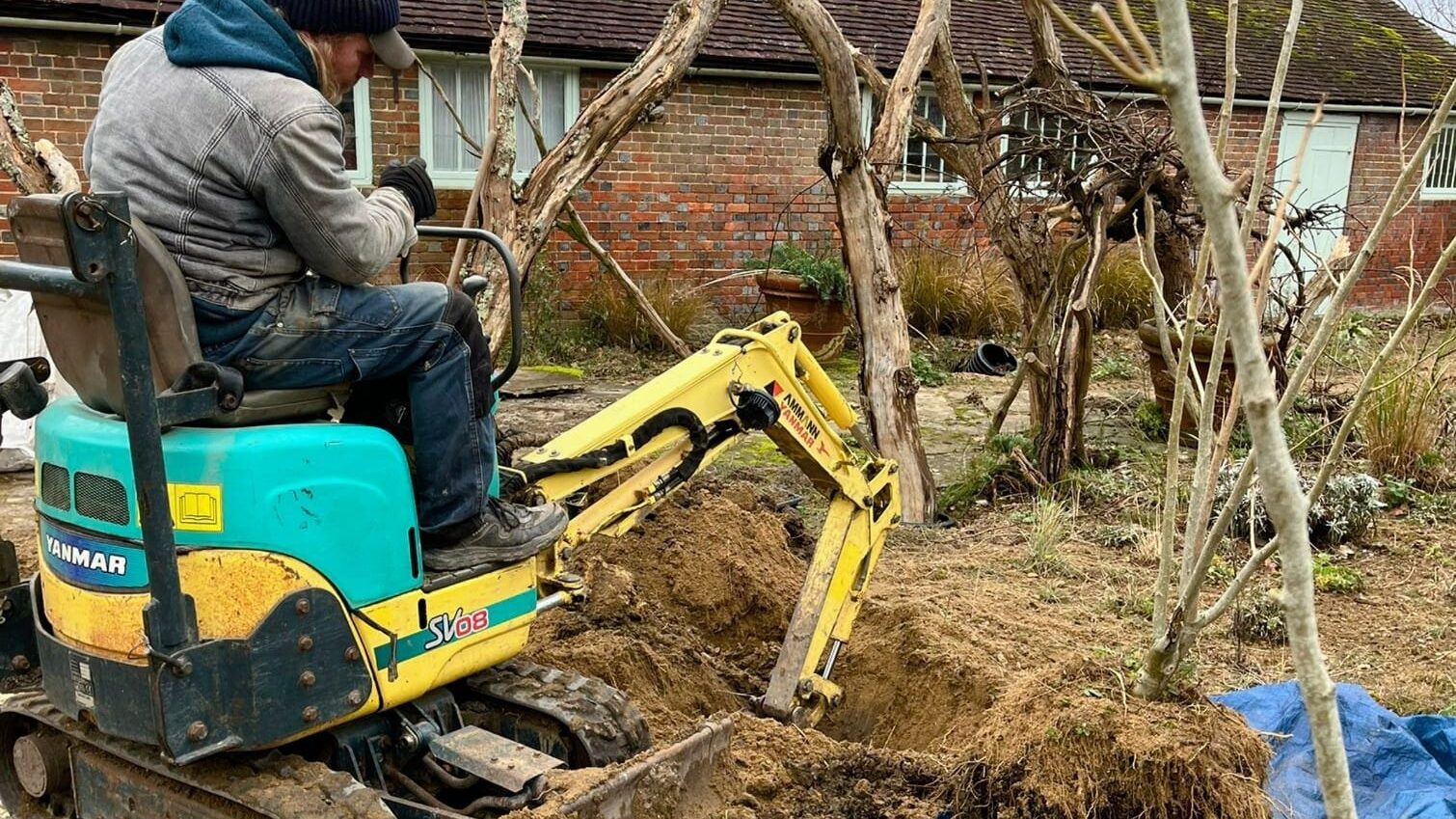
With the other area, on the opposite side of the bisecting path, we wanted to experiment with an alternative approach to dealing with compaction. We raised the root ball of the silk tree but left the ground otherwise unbroken and, after removing perennials and washing the roots, we mounded sand straight on to the surface to a depth of 40cm and replanted. It will be interesting to monitor how these two different methods affect the health and growth of the plants.
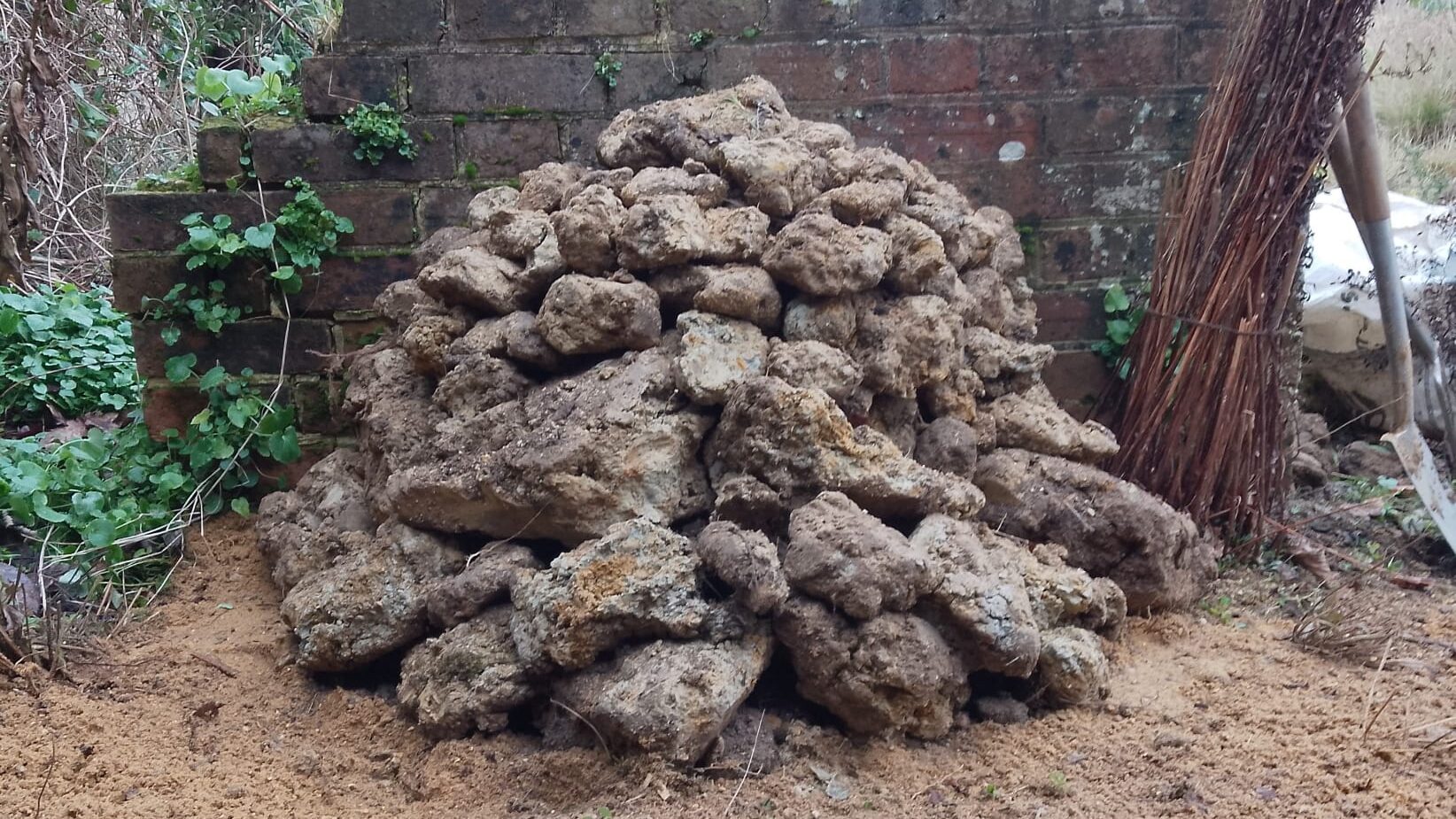
The first snow comes. Dense, slow-falling curtains of weightless flakes settle in the gathering early dusk. A week of hard frosts follow, treating us to extraordinary winter skies. An immense ‘wolf’ moon hangs full and heavy above one horizon while the sun rises on the other, above the Downs, between striated clouds like elaborate confectionary in shades of pinks, purples, oranges, lilacs and baby blue. The remnants of Storm Éowyn and Herminia’s record-breaking 100mph gusts at the end of the month buffet the garden for days. Crows battle the air like dark wet rags thrown into the wind, stands of tall grasses lay flat and the ephemeral pond fills to the high-water mark.
The grim news from across the pond that the US is to withdraw from the Paris Climate Agreement and chilling phrases like “Drill baby, drill” is an unfortunate way to begin the year for anyone who believes incentivising fossil fuels will have an adverse effect on the planet. Although it can be difficult to keep spirits up in the face of such onslaughts, it’s important to remember what separates the dominator from the carer. The Nobel Prize-winning Polish poet Wislawa Szymborska characterised it as having the ability to say, “I don’t know”. Our own green spaces are like sentences that link together to form a story. The caretakers amongst us are exploring in a spirit of enquiry and discovery in how we might turn the tide of blindness to finding solutions, where people and planet can share equal rights and mutual respect.
Main image: Suzi begins digging out perennials in preparation for breaking up the compaction
Photos courtesy of Karen Finley, Charlie Harpur, Moy Fierheller
Visit the Walled Garden for a tour or workshop. Find out What’s On at Knepp.
What we’re reading:
https://www.bbc.co.uk/iplayer/episode/m0026rm1/monty-dons-british-gardens-series-1-episode-4
https://www.bbc.co.uk/programmes/m0026939
Willis, K, Good Nature. The New Science of How Nature Improves Our Health, Bloomsbury Publishing, 2024
https://www.field-studies-council.org/courses-and-experiences/subjects/biodiversity-metric
http://www.natureconservationimaging.com/Pages/nature_conservation_imaging_downland1_bees.php
https://www.instagram.com/bennyhawksbee/p/C85GBETKRWs
https://www.rewildingbritain.org.uk/blog/11-new-projects-backed-by-the-rewilding-innovation-fund

Knepp Wilding Kitchen- Restaurant Supervisor Job Description We are looking for a dynamic, enthusiastic and experienced front-of-house professional looking for a new challenge and to
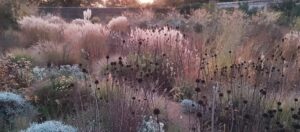
Moy Fierheller | Deputy Head Gardener Published December 2025 Visit Knepp’s rewilded Walled Garden November begins with warmth and rain. The remnants of Hurricane Melissa that caused tragedy and catastrophic

Knepp Wildland PodcastEpisode 43: Headwinds and hope: Tony Juniper on Why Nature Restoration is a path to Economic Growth 2 December 2025 This time we
Knepp Wildland Safaris, our gardens and campsite are all about the quiet and patient observation of nature.
Some of the species we are likely to encounter are shy or can be frightened by loud noises or sudden movements. Our campsite with open-air fire-pits, wood-burning stoves and an on-site pond is unsuitable for small children.
For this reason, our safaris, garden visits, holiday cottages and campsite are suitable only for children of 12 and over.
You’ll receive relevant offers and news by email. This will include information about the Rewilding Project, online store products, the Wilding Kitchen Restaurant / Cafe, and other exciting experiences / events across the Knepp Castle Estate. For more information, view our Privacy Policy.